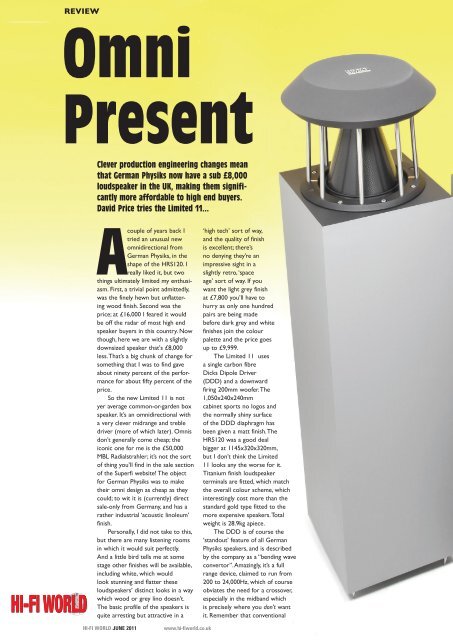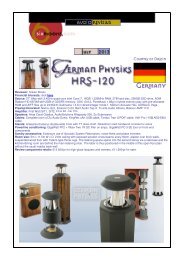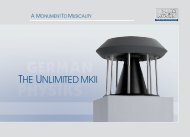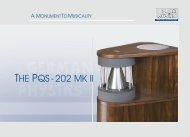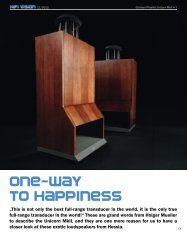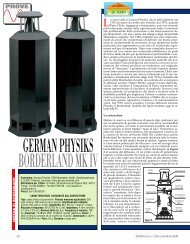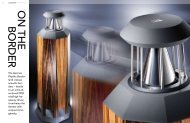Acouple - German Physiks
Acouple - German Physiks
Acouple - German Physiks
Create successful ePaper yourself
Turn your PDF publications into a flip-book with our unique Google optimized e-Paper software.
REVIEW<br />
HI-FI WORLD<br />
Omni<br />
Present<br />
Clever production engineering changes mean<br />
that <strong>German</strong> <strong>Physiks</strong> now have a sub £8,000<br />
loudspeaker in the UK, making them significantly<br />
more affordable to high end buyers.<br />
David Price tries the Limited 11...<br />
A<br />
couple of years back I<br />
tried an unusual new<br />
omnidirectional from<br />
<strong>German</strong> <strong>Physiks</strong>, in the<br />
shape of the HRS120. I<br />
really liked it, but two<br />
things ultimately limited my enthusiasm.<br />
First, a trivial point admittedly,<br />
was the finely hewn but unflattering<br />
wood finish. Second was the<br />
price; at £16,000 I feared it would<br />
be off the radar of most high end<br />
speaker buyers in this country. Now<br />
though, here we are with a slightly<br />
downsized speaker that's £8,000<br />
less. That’s a big chunk of change for<br />
something that I was to find gave<br />
about ninety percent of the performance<br />
for about fifty percent of the<br />
price.<br />
So the new Limited 11 is not<br />
yer average common-or-garden box<br />
speaker. It’s an omnidirectional with<br />
a very clever midrange and treble<br />
driver (more of which later). Omnis<br />
don’t generally come cheap; the<br />
iconic one for me is the £50,000<br />
MBL Radialstrahler; it’s not the sort<br />
of thing you’ll find in the sale section<br />
of the Superfi website! The object<br />
for <strong>German</strong> <strong>Physiks</strong> was to make<br />
their omni design as cheap as they<br />
could; to wit it is (currently) direct<br />
sale-only from <strong>German</strong>y, and has a<br />
rather industrial ‘acoustic linoleum’<br />
finish.<br />
Personally, I did not take to this,<br />
but there are many listening rooms<br />
in which it would suit perfectly.<br />
And a little bird tells me at some<br />
stage other finishes will be available,<br />
including white, which would<br />
look stunning and flatter these<br />
loudspeakers’ distinct looks in a way<br />
which wood or grey lino doesn’t.<br />
The basic profile of the speakers is<br />
quite arresting but attractive in a<br />
HI-FI WORLD JUNE 2011 www.hi-fiworld.co.uk<br />
‘high tech’ sort of way,<br />
and the quality of finish<br />
is excellent; there’s<br />
no denying they’re an<br />
impressive sight in a<br />
slightly retro, ‘space<br />
age’ sort of way. If you<br />
want the light grey finish<br />
at £7,800 you’ll have to<br />
hurry as only one hundred<br />
pairs are being made<br />
before dark grey and white<br />
finishes join the colour<br />
palette and the price goes<br />
up to £9,999.<br />
The Limited 11 uses<br />
a single carbon fibre<br />
Dicks Dipole Driver<br />
(DDD) and a downward<br />
firing 200mm woofer. The<br />
1,050x240x240mm<br />
cabinet sports no logos and<br />
the normally shiny surface<br />
of the DDD diaphragm has<br />
been given a matt finish. The<br />
HRS120 was a good deal<br />
bigger at 1145x320x320mm,<br />
but I don’t think the Limited<br />
11 looks any the worse for it.<br />
Titanium finish loudspeaker<br />
terminals are fitted, which match<br />
the overall colour scheme, which<br />
interestingly cost more than the<br />
standard gold type fitted to the<br />
more expensive speakers. Total<br />
weight is 28.9kg apiece.<br />
The DDD is of course the<br />
‘standout’ feature of all <strong>German</strong><br />
<strong>Physiks</strong> speakers, and is described<br />
by the company as a “bending wave<br />
convertor”. Amazingly, it’s a full<br />
range device, claimed to run from<br />
200 to 24,000Hz, which of course<br />
obviates the need for a crossover,<br />
especially in the midband which<br />
is precisely where you don’t want<br />
it. Remember that conventional
loudspeakers crossing over cause<br />
all kinds of nasties, from peaky<br />
response to phase errors; it’s the<br />
sonic equivalent of letting people<br />
park on roundabouts; just about<br />
the worse thing you could<br />
do to your road system!<br />
Then of course there’s<br />
the omni directional<br />
dispersion pattern,<br />
which can only be a good<br />
thing; done properly a full<br />
range omni answers a vast range of<br />
questions asked by multiple moving<br />
coil cone drivers, and also electrostatics<br />
too. Overall, the company<br />
claims a frequency response of<br />
32-24,000Hz [see MEASURED<br />
PERFORMANCE].<br />
It’s named after<br />
its ‘father', Peter Dicks,<br />
who created his first<br />
design concept in 1978.<br />
It was Mainhattan<br />
Acustik, run by IT<br />
expert Holger Mueller,<br />
who licensed the design<br />
in the early nineties,<br />
which duly led to the<br />
birth of the <strong>German</strong><br />
<strong>Physiks</strong> company. The<br />
driver has since been<br />
refined many times, and<br />
partnered to a downfiring<br />
bass driver (a<br />
200mm diameter unit)<br />
in the same cabinet;<br />
this forms the blueprint<br />
for all the company’s<br />
speakers. The cabinets<br />
have extensive Hawaphon<br />
and felt damping materials<br />
applied inside and are<br />
constructed from heavy<br />
panels of MDF, with internal<br />
reinforcements fitted at<br />
critical points. Minimum<br />
life expectancy is said to<br />
be twenty five years, with<br />
corrosion resistant V4<br />
grade stainless steel for the<br />
DDD driver support pillars,<br />
terminal mounting plates<br />
and all the screws; a five year<br />
warranty is offered.<br />
SOUND QUALITY<br />
As with all speakers that<br />
land in my listening room,<br />
I manoeuvred the Limited<br />
11s into a place that I<br />
‘guesstimated’ would be best.<br />
Not as with all speakers<br />
however, right from the second<br />
the volume was switched on,<br />
the <strong>German</strong> <strong>Physiks</strong> omnis<br />
sounded at home. It was at this<br />
point that I congratulated myself on<br />
my brilliant choice of positions for<br />
them, but the company’s representative<br />
Robert Kelly dryly pointed<br />
out that they work well pretty much<br />
anywhere in a room, anyway. Hmmm!<br />
Anyway, I did do a bit of minor<br />
remodelling, but soon I’d got them<br />
singing, about 3m from each other<br />
and about 50cm from the back of my<br />
long rear wall. The thing to bear in<br />
mind here is that they can deceive<br />
you into thinking you’ve got ‘em<br />
working perfectly, so amenable they<br />
are to rooms, compared to certain<br />
other high end speakers which are<br />
horridly fussy; don’t give up after<br />
your first reposition, they do reward<br />
careful placement even though they<br />
flatter bad rooms and positions.<br />
Not having heard another<br />
<strong>German</strong> <strong>Physiks</strong> loudspeaker since<br />
the HRS120 was cruelly snatched<br />
from my listening room a couple<br />
of years ago, it was fascinating<br />
to suddenly ‘snap back’ to their<br />
distinctive sound. I don’t mean<br />
distinctive as in coloured; indeed it’s<br />
quite the opposite. Here you hear a<br />
loudspeaker with so little apparently<br />
going on, save a few bass issues right<br />
at the bottom end. This latter point<br />
is as much about speaker/room<br />
interaction and setup, as it is about<br />
the speaker itself, incidentally. Imagine<br />
if you would, a clean sweep from<br />
200Hz upwards; as the frequency<br />
rises, the speaker continues to sound<br />
the same. There are no ‘hot spots’, no<br />
periods of strange vibrations or any<br />
other type of misbehaviour; instead<br />
things just sound uniform and even<br />
and true. That, in a nutshell is what<br />
you get from the Limited 11s.<br />
The recent Heathrow hi-fi<br />
show saw Noel and I answering<br />
questions from an audience, and one<br />
which stuck in my mind was that of<br />
how can we (i.e. reviewers) make<br />
our mind up about the sound of a<br />
speaker without listening to ‘real’<br />
(i.e. acoustic, orchestral) music? Well,<br />
dropping the stylus on the A side of<br />
Kraftwerk’s ‘Computerwelt’ reminded<br />
me that electronic music, which<br />
of course has no natural acoustic<br />
signature, can be just as honest a<br />
test of a transducer. The Limited 11s<br />
immediately sounded dextrous, subtle<br />
and detailed; the bassline was<br />
bouncy yet tight; midband was<br />
breathtakingly expansive yet<br />
precise and treble was crisp<br />
and sonorous. This track’s<br />
metronomic beat showed<br />
the fleet footedness of the<br />
DDD driver; it can stop and<br />
start with agility, giving very<br />
little ‘hangover’ from the last<br />
excursion it’s asked to make.<br />
It’s not quite up there with<br />
electrostatics or ribbons, but<br />
not far off and certainly sounds<br />
far closer to these than ye olde<br />
moving coil driver. The result is a<br />
www.hi-fiworld.co.uk JUNE 2011 HI-FI WORLD<br />
REVIEW<br />
HI-FI WORLD
suppleness and fluidity across the mid<br />
which is lovely, allied to a delicacy<br />
coming from the (obviously very<br />
light) carbon fibre structure.<br />
In tandem with this is a bass<br />
response that’s very coherent,<br />
following the events further up the<br />
frequency range with alacrity. There’s<br />
less of a sense of two drive units<br />
than with a mid-price Martin Logan,<br />
for example; things integrate well.<br />
The lovely bass synth cadences of<br />
‘Computerwelt’ came through very<br />
nicely timed; indeed in my room<br />
they worked better than the larger<br />
HRS120, which as I alluded to earlier<br />
tended to ‘over drive’ the room a tad.<br />
The Limited 11 sounds tighter and<br />
drier than its bigger brother then,<br />
which suits the main DDD driver a<br />
treat, as this is precisely what it is.<br />
On paper, it goes down a few Hertz<br />
less, but I can’t say it’s noticeable,<br />
even on the subsonics imprinted into<br />
the groove of ‘Computerwelt’. The<br />
baby GP speakers sounded crisp and<br />
firm and all of a piece with events<br />
further up top.<br />
Moving to Herbie Hancock’s<br />
‘The Prisoner’, a lovely piece of<br />
late sixties acoustic jazz, and these<br />
speakers showed themselves to have<br />
tonal purity that’s unexpected even<br />
in products of this price. B&W802s,<br />
for example, are many fine things but<br />
when I listen I still hear their Kevlar<br />
cones across the upper mid; by<br />
contrast the Limited 11s seemed to<br />
have less in the way of innate ‘tone’<br />
with piano and double bass. There<br />
was a satisfyingly sense of ‘being<br />
there’ to the performance. I wouldn’t<br />
claim that they’re as transparent as<br />
a Martin Logan panel in this respect,<br />
but again they came close without<br />
the attendant mid/bass integration<br />
issues. Better still, this superb Blue<br />
Note recording came over with<br />
cavernous size; maybe not the Grand<br />
Canyon, but the GPs certainly did a<br />
passable impersonation of the Avon<br />
Gorge. Once you’ve got them close<br />
enough in the room, or turned the<br />
volume up sufficiently, instruments<br />
lock into place in the soundstage<br />
and you’re there. It’s the ease of<br />
soundstaging and general effortlessness<br />
which impresses; funnily<br />
enough though you get used to<br />
it and it’s only when you go back<br />
to conventional speakers that the<br />
imaging and phase sounds so out of<br />
sorts.<br />
Acoustic Triangle’s ‘Placet<br />
Futile’, startlingly well recorded on<br />
SACD, showcased the tonal purity<br />
and unbridled evenness of these<br />
loudspeakers. The Limited 11s<br />
thrived, with sparkling harmonics<br />
from the piano, a wonderfully tangible<br />
clarinet and a profound sense of air<br />
and space. They let the recording’s<br />
flavour pour out into my listening<br />
room, as if the studio barrier had<br />
been breached and the music was<br />
overflowing. The location of the<br />
respective instruments, and indeed<br />
the microphones capturing them,<br />
was laid before me with forensic<br />
accuracy. The overall effect was<br />
mesmerising, the only concession<br />
to it being a recording rather than<br />
a moody live jazz space was the<br />
bass. Yes, of course you can hear<br />
the two drive units gently brushing<br />
up alongside one another, but this<br />
is so deep down that it’s no worry.<br />
In my listening room, there was no<br />
sense of lumpiness or boom, or blur<br />
or slur; only the slightest ‘hint of<br />
box’ was heard. This is nothing to<br />
be ashamed of, as I’ve never heard<br />
a box loudspeaker doesn’t allude<br />
to the way it’s constructed. The<br />
Rondo from Mozart’s<br />
‘Wind Serenades’<br />
(Chamber Soloists of<br />
the Royal Philharmonic<br />
Orchestra) again<br />
proved the Limited 11’s<br />
mettle; a deliciously<br />
accurate tone to<br />
brass and woodwind,<br />
plus acres of air and<br />
everything held in<br />
perfect proportion.<br />
The only music<br />
type I tried which<br />
in any way raised<br />
questions with these<br />
speakers was rock;<br />
they actually sounded<br />
very pleasing replaying<br />
America’s ‘Ventura<br />
Highway’, but they<br />
lacked the drama of<br />
my Yamaha NS1000Ms<br />
(which I am ashamed to<br />
say had been made to<br />
sound rather ordinary<br />
with jazz and classical).<br />
They may be £8,000<br />
speakers but they lack<br />
the sheer physical<br />
presence of some rivals;<br />
Usher’s £10,500 Be-10<br />
have more heft, more<br />
punch, more power,<br />
more of a tiger in their<br />
tank. The <strong>German</strong><br />
<strong>Physiks</strong>, by contrast,<br />
www.hi-fiworld.co.uk JUNE 2011 HI-FI WORLD<br />
REVIEW<br />
sound more petite, REFERENCE SYSTEM:<br />
precise and poised, but Marantz TT-1000 turntable<br />
ultimately weaker and Icon Audio PS3 phono stage<br />
less impactful; at very NuForce P9 preamp<br />
high levels there’s the NuForce Ref. 9SE power<br />
sense that they don’t M. Fidelity AMS35i amp<br />
quite have the sheer Yamaha NS1000M speakers<br />
horse power. <strong>German</strong><br />
<strong>Physiks</strong> would surely<br />
retort, ‘so get the HRS120’, but that’s<br />
another £8,000 spons you need to<br />
find!<br />
CONCLUSION<br />
In many ways I liked the <strong>German</strong><br />
<strong>Physiks</strong> Limited 11 more than the<br />
larger and pricier HRS120 I reviewed<br />
way back when. As a package they’re<br />
brilliant, giving ‘essence of <strong>German</strong><br />
<strong>Physiks</strong>’ to a far wider market, and<br />
in some ways giving away little or no<br />
performance to boot. If you want<br />
a spacious, even, clean and precise<br />
sounding loudspeaker for a medium<br />
to large-ish room – and listen to<br />
most types of music – then they’re<br />
truly first rate contenders. Only<br />
headbanging rock fiends wanting big<br />
bore bass will find them wanting. As<br />
such, I’d wholeheartedly recommend<br />
them – providing of course your<br />
decor suits the light grey lino; if not<br />
wait for the unlimited ones and get<br />
the white!<br />
Frequency response from an omnidirectional<br />
loudspeaker like this one<br />
looks far more ragged than a forward<br />
firing design, due to the amount of<br />
return energy from room surfaces,<br />
even with our gated, sine wave burst<br />
measurements designed to minimise<br />
this problem. However, fast ‘chirp’ tests<br />
and pink noise both showed the Limited<br />
11 has a good pressure level balance<br />
in any direction, and our pink noise<br />
analysis, published here, clearly shows<br />
this. There are no significant tonal<br />
imbalances and even though subsonic<br />
output is limited by an internal series<br />
capacitor the Limited 11 still managed<br />
to energise our 28ft measuring room’s<br />
mode at 24Hz, so it will have low bass.<br />
Overall, the Limited 11 looks very<br />
balanced, but in truth there is much<br />
more treble energy being put into the<br />
room from an omnidirectional unit<br />
and this means that subjectively the<br />
balance will sound bright or light, due<br />
to reflected energy from walls, ceiling<br />
etc.<br />
Sensitivity was on the low side at<br />
83dB Sound Pressure Level from one<br />
nominal watt (2.8V) of input. A high<br />
impedance of 8 Ohms was one reason<br />
for this, although the bass unit is still<br />
4 Ohms our impedance graph shows.<br />
Current draw at low frequencies will be<br />
very even as there are no bass peaks,<br />
so something different is happening<br />
here. Bass damping is good according<br />
MEASURED PERFORMANCE<br />
to the impedance and response plots,<br />
so the Limited 11 will likely have well<br />
controlled bass, but this is not a bass<br />
heavy design by any means; it will likely<br />
sound a little light low down.<br />
Colouration was reasonably well<br />
controlled, but the cabinet looks a little<br />
lively at low frequencies.<br />
The Limited 11 is obviously a well<br />
developed design likely to give a good<br />
sound. It will almost certainly have a<br />
light balance though. NK<br />
FREQUENCY RESPONSE<br />
+20<br />
+10<br />
dB<br />
0<br />
-10<br />
-20<br />
-30<br />
20 100 Hz 1k 20k<br />
Green - driver output<br />
Red - port output<br />
IMPEDANCE<br />
50<br />
Ohms<br />
30<br />
10<br />
HI-FI WORLD<br />
VERDICT<br />
Expansive beyond almost all others in<br />
its class, this superb loudspeaker is<br />
for lovers of crisp, accurate, neutral<br />
and open sound.<br />
GERMAN PHYSIKS<br />
LIMITED 11 £7,800<br />
www.german-physiks.com<br />
FOR<br />
- sublime soundstaging<br />
- speed, musicality, dynamics<br />
- delicate tonality<br />
AGAINST<br />
- slightly limited bass<br />
- grey finish!<br />
0<br />
10 Hz 1k 20k


